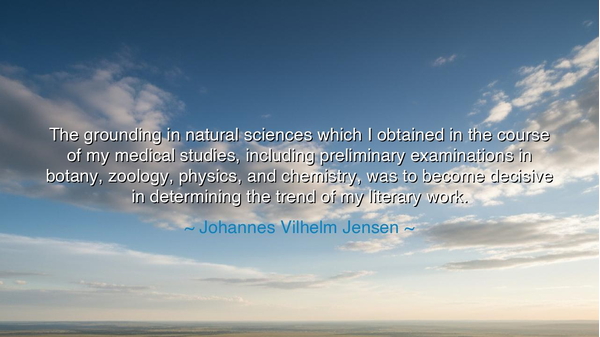
The grounding in natural sciences which I obtained in the course
The grounding in natural sciences which I obtained in the course of my medical studies, including preliminary examinations in botany, zoology, physics, and chemistry, was to become decisive in determining the trend of my literary work.






In the contemplative and visionary words of Johannes Vilhelm Jensen, there resounds the harmony of intellect and imagination: “The grounding in natural sciences which I obtained in the course of my medical studies, including preliminary examinations in botany, zoology, physics, and chemistry, was to become decisive in determining the trend of my literary work.” These words, though spoken by a man of letters, reveal a truth that bridges the realms of science and art — that knowledge, when united with wonder, gives birth to wisdom. Jensen reminds us that the human spirit flourishes not in isolation, but in the marriage of observation and creation, reason and inspiration. For he who knows the workings of nature learns also the mysteries of the soul.
The meaning of this quote lies in the understanding that science is not the enemy of art, but its most steadfast companion. Jensen, trained in the natural sciences, saw in the study of life’s smallest details the poetry of existence itself. The roots of a plant, the beating of a heart, the pull of gravity, the dance of light — these were not mere facts to him, but symbols of the eternal order that binds all things. Through botany, he learned of growth; through zoology, of instinct; through physics, of motion and law; through chemistry, of transformation. And it was from these disciplines that he drew the raw materials of his literature. His stories breathed not only emotion, but the rhythm of the cosmos — the pulse of life itself.
The origin of this insight lies in Jensen’s own journey as both scholar and artist. Born in Denmark in 1873, he pursued medical studies before devoting himself fully to writing. Yet the disciplines he once studied never left him. They became the foundation upon which his imagination soared. His literary works — epic, philosophical, and deeply human — were woven with threads of scientific understanding. He wrote of evolution, of the rise of humanity, of the unity of all living things. In his vision, science was not cold or mechanical, but sacred — the language through which creation spoke to those who listened. It was this fusion of knowledge and wonder that earned him the Nobel Prize in Literature in 1944, and secured his place among those rare thinkers who saw no boundary between the laboratory and the lyre.
The ancients, too, understood this sacred union. The philosopher Aristotle, who taught both the sciences and the arts, declared that knowledge begins in wonder — that to observe nature with awe is the first step toward wisdom. Likewise, Leonardo da Vinci, centuries later, painted with a scientist’s precision and studied anatomy with an artist’s reverence. In the veins of a leaf or the geometry of a bird’s wing, he saw divine proportion, the harmony of creation. Jensen stands in this lineage — a descendant of those who knew that truth and beauty are one, and that to understand the structure of the world is to glimpse the face of the eternal.
There is a deep emotional power in Jensen’s reflection, for it speaks to the hunger within all human beings — the longing to understand and to express, to unite knowledge with meaning. The natural sciences teach us the mechanics of existence, but literature gives those mechanics a soul. The biologist may describe the heartbeat; the poet makes us feel it. The physicist may explain the movement of the stars; the storyteller helps us find our place among them. In this way, Jensen’s life reminds us that knowledge without imagination is sterile, and imagination without knowledge is blind. Together, they form the wholeness of understanding that every human spirit seeks.
We may also see this truth reflected in the life of Goethe, the German poet and scientist, whose studies of color and nature informed his art. Goethe once said that nature is the living garment of God — that through her, we glimpse the divine order. His poetry was born of the same source as his science: an endless curiosity and reverence for the world. So too was Jensen’s. Both men saw in the details of matter the handwriting of the infinite. To study the natural world, they believed, was not merely to collect facts, but to commune with creation itself.
The lesson we draw from Jensen’s words is clear and radiant: do not divide your mind between knowledge and wonder. To learn is to love the world more deeply; to observe is to worship its design. Let the study of science awaken humility, and let the practice of art give it voice. The scientist who gazes through the microscope and the poet who gazes at the moon seek the same truth — the unity that underlies all being. If you wish to create, first understand; if you wish to understand, first observe with awe.
So let the teaching of Johannes Vilhelm Jensen be passed to future generations: that the wisdom of the world is not found in one discipline, but in the harmony between them. The heart of science and the soul of art are but two reflections of the same divine flame. Seek both, nurture both, and let them guide you toward creation that honors truth, and truth that sings with beauty. For when knowledge and imagination walk hand in hand, the human spirit approaches its highest form — that of the seer, who looks upon the world and whispers, “All this is one.”






AAdministratorAdministrator
Welcome, honored guests. Please leave a comment, we will respond soon